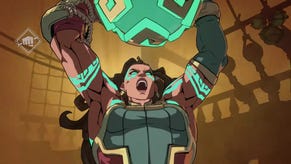Tomb Raider is tops, but multiplayer feels unnecessary
Tomb Raider launches today, and while it's met with very few complaints, Brenna's got one - she wants more, and she doesn't want it delivered multiplayer-style.
A good multiplayer mode keeps you focused on a single game for many more hours than the single-player can. Those who lose hours to the multiplayer are more likely to feel that they got their money’s worth purchasing the game; they’re unlikely to trade the game in; and they may even splurge on ancillary DLC like cosmetic items or random drops, ensuring an alternate source of revenue.
When you fire up Tomb Raider today - and I sincerely hope you do, because I loved it - you'll be greeted by a stylish menu screen complete with beefy audio and slick transition animations. If you're impatient, you'll already by hitting the button for "new game", but assuming you like to savour your games, you may poke around in there a bit. After you've remembered what "invert" means to sort out your camera and browsed the locked galleries which promise spoils for skilled adventurers, your eye may wander to two mysterious menu items: downloadable content, and multiplayer.
"In the console space you need to do anything to make sure that that disc stays in the tray," Gears of War creator Cliff Bleszinski wrote in a recent blog post. You can't expect consumers to keep playing the same single-player experience over and over again, and when the cost of that experience is as high as it is, you can't really blame them for taking advantage of trade-ins and rentals.
What you can do is give them a reason to buy and keep the game. DLC is a good way; whether it's a series of free hefty content updates like Halo 4's co-operative episodes, or even the promise of regular premium content drops represented by a season pass. Multiplayer is another.
A good multiplayer mode keeps you focused on a single game for many more hours than the single-player can. Gears of War, Mass Effect, Uncharted and Assassin's Creed are excellent examples; all three were primarily single-player experiences which many doubted could make the transition to multiplayer. But they did, and have been extremely successful in terms of player numbers and hours spent. Those who lose hours to the multiplayer are more likely to feel that they got their money's worth purchasing the game; they're unlikely to trade the game in; and they may even splurge on ancillary DLC like cosmetic items or random drops, ensuring an alternate source of revenue.
Other games are almost certain to hit the jackpot in the same way, and you can't blame publishers for having a go - as long as doing so doesn't divert resources from the single-player side of things. But when it goes wrong, it really goes wrong - think of Spec Ops: The Line, which split critics for its bold narrative but was almost universally derided for its lacklustre multiplayer. Others are just a bit forgettable; we haven't heard much about Far Cry 3, either positive or negative, for example.
If there was ever a poster boy for single-player games it is the Tomb Raider franchise. Oh, they're great fun to play with friends, assuming your buddies aren't of the "pull that switch. That switch. Pull the SWITCH you numbnuts it's right in front of your face, oh it's a candle" type. But a lone adventurer plumbing the depths of ancient caverns while woodenly flinging herself between towering structures and fleeing backwards from endangered enemies does not present an immediately obvious multiplayer hook.
So why the heck has Square Enix shoehorned it in? Well, for the business reasons stated above. It was lucky enough to have Eidos Montreal (sitting idle while waiting for Thief 4's long overdue next-gen reveal, I suspect) to develop the multiplayer, meaning Crystal Dynamics didn't have to make any sacrifices to get it up and running. But also because Tomb Raider's combat is such an improvement on past entries that you may well want to do some more of it.
Lara's moves are frequently and accurately described as brutal, and although her handling of weapons never entirely loses its amateur, clumsy feeling, it improves as she upgrades her gear. By the final hours of the campaign she's a frighteningly efficient mass murderer and it's kind of hard to let go of the compact but delightful toolbox of goodies she ends up with. Thanks to the multiplayer mode, you don't have to.
Time will tell whether Square Enix’s investment was worth it. From my very cursory glance, Stace’s preview, and Eidos Montreal’s own comments, I suspect the answer may be “no”.
To invoke the games writer's favourite cliche, time will tell whether Square Enix's investment was worth it. From my very cursory glance, Stace's preview, and Eidos Montreal's own comments, I suspect the answer may be "no". This isn't a review of the multiplayer. I have no critique to offer beyond the fact that I simply haven't the slightest interest in signing up to shoot more faces, despite the attraction of unusual asymmetrical modes. Neither Pat nor Dave have shown any enthusiasm, either. Maybe it'll go great guns, suck us in, and we'll be proven wrong; it wouldn't be the first time.
But what I actually did want, as soon as the credits rolled on Tomb Raider, was more of what I'd just had. It's far, far too early to start nagging Crystal Dynamics for a sequel, and I hope the team takes another five years or so if that's what a finished product of such quality requires - but that other menu item, downloadable content, certainly has my attention. My wallet is ready, Square Enix; what are you going to do to keep the disc in the tray?
Tomb Raider is out now on PC, PlayStation 3 and Xbox 360. It has reviewed very well so far, although it's worth noting that PC code has not been made available.











